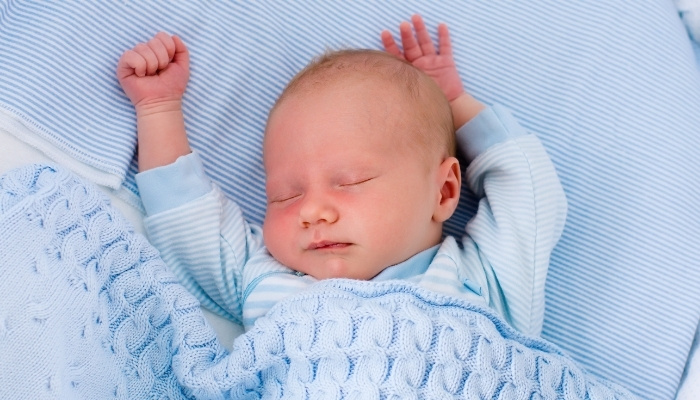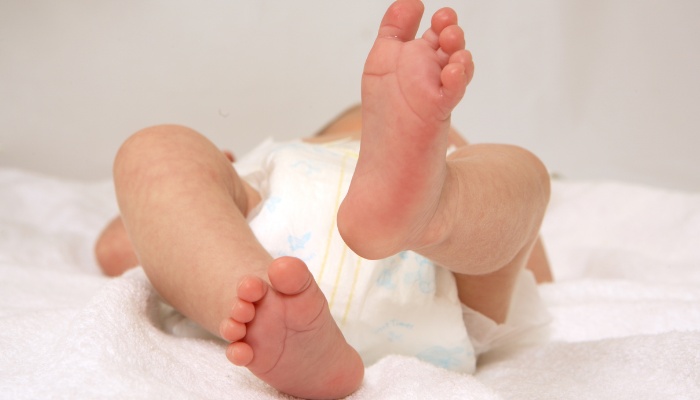You will witness your infant engaging in the most adorable and unusual behaviors as they develop.
One day they’re bringing their feet to their face to grab and “eat” their toes. The next moment, they’re thumping their legs down hard.
Understandably, this behavior can seem a little extreme coming from your delicate bundle — so what does it mean?
Infants commonly kick and slam their legs down for various reasons including to expel trapped gas, relieve teething pain and discomfort, and build on their coordination and muscle strength. In rare cases, leg-slamming can be linked to the neurological disorder periodic limb movement disorder (PLMD).
It’s quite normal for babies to be restless sleepers, especially as newborns. Common discomforts of gas, teething, and hunger pangs can also cause them to fidget like this during the day.
Read on to find out the reasons behind this behavior, tips to stop it, and when to be concerned.
Explanations for Baby Slamming Legs
It might seem to be an alarming behavior in your little one, but most of the time, there is a good and benign reason behind this leg-slamming habit in babies. Let’s look at all of the things it could be…
1. Self-Soothing Behavior
You can’t be there 24/7 to rock them to sleep, so your baby will discover that they can move their body in rhythmic ways that may help them fall back into a slumber.
Lifting their legs and beating their feet is just one form of self-soothing for your little one.
2. An Attempt To Relieve Pain or Discomfort
Two common culprits of pain and discomfort in infants are teething and hunger. Hunger pangs may cause your baby to slam their legs down on their bed or play mat when they want to feed.
They may also do this to distract themselves or relieve pressure from the pain of teething too, and who can blame them?
3. Trying To Work Out Excess Gas
We all know how uncomfortable excess gas is. Sometimes we’ll move around to help nature along, and your baby is no different, but since they can’t walk yet, they’ll commonly try a forceful activity like lifting and slamming their legs for relief!
4. Building Coordination and Muscles
Seeing your baby kick and stretch their legs in this way can be a sign of a healthy milestone in the development of their nervous system.
This jerky movement seen in sleep or during the day is your baby’s way of practicing muscle use, helping them to build better flexibility and coordination.

5. Stress Reliever
Lifting and hitting the legs back down can also be a stress-relieving technique in babies.
If your little one is feeling anxious or stressed by something, jerking their legs up and down can be a way of releasing feelings of tension and addressing their anxious state.
6. Too Much Stimulation Before Bed
If your munchkin’s bedtime routine has gone by the wayside lately or something has disrupted it to make them overstimulated, such as a sudden temperature change or different noises, you may notice them pounding their legs down to release some extra energy.
7. Restless Leg Syndrome
Restless legs syndrome or RLS is an uncontrollable need to move the lower limbs in response to pain or discomfort and usually occurs when children are awake, according to pediatric healthcare provider Children’s Health.
RLS can be managed easily and is sometimes associated with an iron deficiency.
If these limb movements are happening frequently during the day, it’s a good idea to speak with your baby’s pediatrician to determine the exact causes.
8. Periodic Limb Movement Disorder
Periodic limb movement disorder (PLMD) is an uncommon neurological condition that affects a child’s ability to lie still during the night.
Movements such as jerky legs, foot flexes, and kicks normally occur in clusters during non-REM (rapid eye movement) sleep every 20-40 seconds.
Babies with restless leg syndrome can go on to develop PLMD, but unlike RLS, PLMD mostly occurs during sleep only.
PLMD itself is not dangerous in babies, but as these leg movements can severely disrupt their sleep quality in the long term, it can have detrimental effects in terms of irritability, poor concentration, and even depression.
Tips To Help Stop Baby Leg Slamming
There are many simple ways to help your little one relax their limbs, especially if it’s a case of being gassy or overstimulated before bed.
Mom Cynthia of the blog Home Beautifully shares these great tips:
- Try swaddling – Wrapping your newborn in swaddling material keeps their limbs close to their body and is designed to give them the close cocooned feeling of being in the womb, which may limit the leg slamming.
- Use gentle massage – This can be great for helping them work out trapped gas or simply relaxing their body before sleep. Here are some great massaging techniques to try including chest, arm, and leg massage!
- Give them a pacifier – A pacifier can ease the discomfort and unease brought on by teething, helping them to self-soothe using something other than their legs. Consider teething rings and teething biscuits to help reduce daytime leg kicking too.
- Create a relaxing sleeping environment – Is the temperature just right in your baby’s sleeping space? Could the lighting, humidity, or noise levels be triggering their leg-slamming behavior? Consider all the ways you could make their nursery a relaxing haven for sleep.
Baby Movements While Sleeping
It’s common and perfectly normal for babies to wriggle their limbs during sleep and even move their heads occasionally.
This is simply a sign that their brain is active, and these movements appear sudden and frequent because babies pass in and out of REM sleep continuously, experiencing light and deep sleep states at a much faster rate than adults.
According to Healthline, these sleep twitches in babies are known as “myoclonic twitches” and are responsible for sudden muscle contraction (positive myoclonus) and muscle relaxation (negative myoclonus).
Hiccups and the sensation of falling during sleep are a form of myoclonic twitching.

When To Be Concerned About Baby Sleep Behavior
If you notice that your baby’s leg slamming or limb twitching is recurrent or excessive, i.e., occurring frequently both day and night, it may indicate a more serious health condition.
Share these concerns with your baby’s pediatrician so they can assess whether or not these are a normal part of your baby’s development.
You should also notify your healthcare professional if your baby’s nighttime movements are causing injury, poor concentration during the day, and frequent waking at night.
Related Questions:
What Is the Most Common Infant Sleeping Problem?
Night waking has been identified by parents and childcare professionals as one of the most common behavioral sleeping problems in both infants and toddlers.
Some findings have revealed that between 25 and 50 percent of children over the age of six months continue to awaken during the night.
Is PLMD Dangerous?
According to Medical News Today, primary PLMD (periodic limb movement disorder) is not considered medically serious.
However, complications may occur as a result of having the condition. Possible complications include chronic insomnia, problems with memory and attentiveness, and generally poor sleep quality.
Final Thoughts
Babies typically slam their legs down for benign reasons such as a self-soothing technique to relieve gas and teething pains.
It can also indicate a healthy milestone in their development as it shows their leg muscles are becoming stronger and more coordinated.
If these movements occur frequently enough to cause regular nighttime waking, it will go on to impact their cognitive function in the daytime, so it’s important to speak to your baby’s pediatrician if you have serious concerns about their sleep behavior or quality.
Rebecca is a seasoned copywriter and researcher with over a decade of experience, specializing in parenting topics. With a passion for all aspects of raising children, from breastfeeding to potty training.

